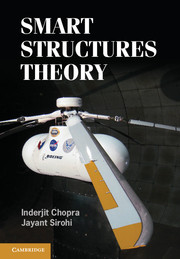Book contents
- Frontmatter
- Contents
- Preface
- 1 Historical Developments and Potential Applications: Smart Materials and Structures
- 2 Piezoelectric Actuators and Sensors
- 3 Shape Memory Alloys (SMAs)
- 4 Beam Modeling with Induced-Strain Actuation
- 5 Plate Modeling with Induced-Strain Actuation
- 6 Magnetostrictives and Electrostrictives
- 7 Electrorheological and Magnetorheological Fluids
- 8 Applications of Active Materials in Integrated Systems
- Index
- References
7 - Electrorheological and Magnetorheological Fluids
Published online by Cambridge University Press: 18 December 2013
- Frontmatter
- Contents
- Preface
- 1 Historical Developments and Potential Applications: Smart Materials and Structures
- 2 Piezoelectric Actuators and Sensors
- 3 Shape Memory Alloys (SMAs)
- 4 Beam Modeling with Induced-Strain Actuation
- 5 Plate Modeling with Induced-Strain Actuation
- 6 Magnetostrictives and Electrostrictives
- 7 Electrorheological and Magnetorheological Fluids
- 8 Applications of Active Materials in Integrated Systems
- Index
- References
Summary
The previous chapters discuss the properties and behavior of active materials that existed in a solid state. These materials exhibited changes in properties and physical dimensions when subjected to an electric, magnetic, or thermal field. A special class of fluids exists that change their rheological properties on the application of an electric or a magnetic field. These controllable fluids can generally be grouped under one of two categories: electrorheological (ER) fluids and magnetorheological (MR) fluids. An electric field causes a change in the viscosity of ER fluids, and a magnetic field causes a similar change in MR fluids. The change in viscosity can be used in a variety of applications, such as controllable dampers, clutches, suspension shock absorbers, valves, brakes, prosthetic devices, traversing mechanisms, torque transfer devices, engine mounts, and robotic arms. Other applications such as electropolishing do not rely directly on the change in viscosity but rather on the ability to change properties of the fluid locally.
Most mechanical dampers consist of fixed damping that is designed as a compromise between a range of operating conditions. As a result, these devices do not provide an optimum level of damping for any specific operating environment. Using ER/MR fluid dampers, variable damping levels can be obtained, and the system performance can be optimized over a wide range of operating conditions. In such dampers, the resistance to flow and, consequently, the energy dissipation, can be modulated through the applied electric or magnetic field.
- Type
- Chapter
- Information
- Smart Structures Theory , pp. 685 - 738Publisher: Cambridge University PressPrint publication year: 2013



